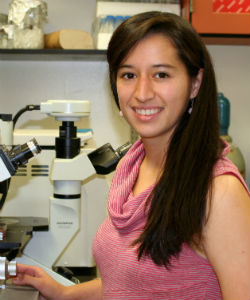
Lorena Infante Lara, Ph.D.
Department: Biochemistry, 2018
Faculty Mentor: Neil Osheroff, Ph.D.
Dissertation Title: Exploring two new modalities of topoisomerase II-targeting drugs to enhance specificity for cancer cells
Dissertation Abstract: Type II topoisomerases are enzymes that transiently cut the DNA to regulate supercoiling and remove knots and tangles from the genome. Although they are essential for cell survivability, these enzymes are potentially genotoxic as they have the ability to fragment the genome. Compounds that stabilize the covalent cleaved DNA-enzyme “cleavage complex” are called topoisomerase II poisons because they convert the enzyme into a cellular toxin. Consequently, topoisomerase II poisons are commonly employed as chemotherapeutic agents. Humans express two closely related isoforms, topoisomerase IIα and IIβ. As every cell in the body expresses either the α or β isoform, topoisomerase II poisons can induce cytotoxicity in non-cancerous cells. It is therefore imperative to develop new or improved topoisomerase II poisons with enhanced target specificity. Two approaches were undertaken to this end: a medicinal chemistry and a DNA-targeting approach. First, seven acridine-related compounds were synthesized and their activity against topoisomerase IIα was characterized. Five of the compounds were topoisomerase IIα poisons, but were not as potent as amsacrine or etoposide. The compounds displayed hallmark characteristics of covalent poisons. Second, the ability of topoisomerase II to mediate cleavage at specific DNA sequences was tested. The initial sequence used for the “oligonucleotide-linked topoisomerase inhibitor” (OTI) encompassed the PML translocation breakpoint of a patient with acute promyelocytic leukemia. Subsequent OTI sequences were derived from the observed translocation between PML and RARA. Results indicate that OTIs (that contain a covalently-linked etoposide core) can direct the sites of DNA cleavage mediated by topoisomerase IIα and IIβ. OTIs increased levels of enzyme-mediated cleavage by inhibiting DNA ligation, and OTI-containing cleavage complexes were as stable as those induced by free etoposide. OTIs directed against the PML-RARA translocation displayed cleavage specificity for oligonucleotides with the hybrid sequence over those with sequences matching either parental gene. OTIs were unable to preferentially induce topoisomerase II-mediated cleavage on their target compared to a sequence with a single SNP. These studies demonstrate the feasibility of using oligonucleotides to direct topoisomerase II-mediated DNA cleavage to specific translocation sites in the genome.
